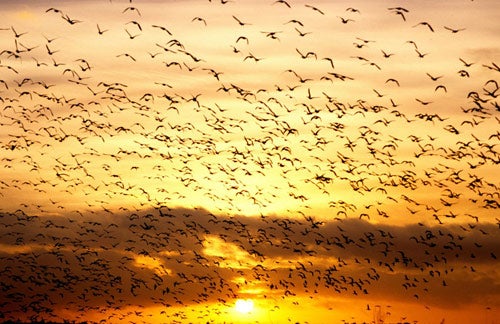Reach for the skies on the Norfolk coast
Some of Britain's best birdlife can be found along this wild stretch, says Mark Rowe

The horseshoe of coastline that runs around the north of Norfolk is a magical place in winter. The flatlands open up vast skies, often filled with flocks of wintering birds, and present the visitor with a sense of end-of-the-world remoteness and desolation, augmented by a bleak coastline that muscles right up to the grassy mudflats and mires – a reminder that this part of England is effectively a very long inland beach.
This walk was recommended by Paul Dickson, a former employee of the National Trust, who has made Norfolk his home. It encapsulates classic north Norfolk scenery and includes the option to extend the walk by seven miles by exploring the vast spit of Blakeney Point. Start it at dawn or arrange to be walking in mid-afternoon and you have every chance of spotting a mass of pink-footed geese – half the world's population of this goose overwinters in north Norfolk – bookending the day by leaving or returning to their marsh sleeping quarters. Flying in vast Vs against a backdrop of orange light, this is one of the most extraordinary wildlife spectacles Britain offers.
The walk starts from a car park that almost seems to tumble into the sea, north of the village of Cley, where an abandoned café, steadily being reclaimed by the elements, may well be your only company. Head inland along the sea wall, waymarked as the Norfolk Coast Path, towards the village. To the left is Cley Marshes National Nature Reserve, managed by the Norfolk Wildlife Trust. The pools and scrapes are flush with unusual and interesting birds throughout the year and you may hear bitterns or catch sight of shelduck, which in flight resemble airborne chessboards.
The path heads into Cley, swinging right and following the coastal path acorn signs behind Cley windmill, which dates from the 1700s and is open to the public. Walk through the windmill's courtyard and take the waymark to the right on to a narrow path above the River Glaven and pass the George pub.
The path joins Cley main street opposite a telephone box and the old chapel where you turn right and then bear right again with the main road (the A149) as it leaves Cley. Take the steps up to the right and cross the River Glaven and then turn right, again following the coastal path acorn sign. Keep to the lower track below the sea wall and follow it, bearing left after 300 yards. The track circumnavigates Blakeney Freshes, reclaimed grazing marshes that will be full of over-wintering wildfowl at this time of year, including, with luck, small flocks of pink-footed geese and oystercatchers grazing the vegetation.
The path follows the river as it makes for the sea before abruptly turning left as the watercourse hits the solid lump of shingle spit. Freed from its canal straitjacket, the Glaven broadens substantially and picks up speed as it heads to the harbour. The views are startlingly bleak, with the dunes of Blakeney Point two miles distant, and boats marooned, seemingly dropped from the skies, but in fact adjacent to sunken and hidden tidal water channels.
The sea wall brings you into Blakeney. Turn left past a wildlife conservation area, where you may see a large snowgoose chugging around on the still waters. Pass in front of the Manor Hotel, keep straight on through a gate and climb up the modest grassy hill for a superb view across the landscape. The deserted café where you began is a mere dot to the east, while westward the view takes in the tip of Blakeney Point and Holkham. In any kind of wind, you may well hear the haunting honking of unseen, distant geese.
Retrace your steps to the gate and walk up Back Lane to the junction with the A419, and turn left. St Nicholas' Church, just across the road, is that rarity, a rural church open daily. It rewards a visit: its chancel was part of a Carmelite friary founded in 1296 and there is an impressive 15th-century hammerbeam roof. You can climb the tower on Friday afternoons.
From the church follow the A419 for the final mile back to Cley. A relatively new footpath means you can avoid the traffic all the way. Back in the village, bear left by the phone box to retrace your steps along the River Glaven and past the windmill to the car park. If you have time or energy, it is really worth exploring Blakeney Point. Make it to the very end of the point and back and you'll clock up seven miles, passing dunes and having a decent chance of seeing grey and common seals hauled out on the sands.
Compact facts
DISTANCE: Six miles for the loop from Cley beach car park. Add on seven more if you walk to Blakeney Point.
TIME: Three hours (six for Blakeney Point).
OS MAP: Explorer 251, Norfolk Coast Central.
The Coast Hopper bus service runs along the coast from Sheringham to Hunstanton and King's Lynn (norfolk.gov. uk). Mark Rowe stayed at New England Cottages, Sedgeford, courtesy of Norfolk Country Cottages (01603 871872; norfolkcottages.co.uk), which are available from £308 per week. Contact Norfolk Tourism (visitnorfolk.co.uk).
Join our commenting forum
Join thought-provoking conversations, follow other Independent readers and see their replies
Comments
Bookmark popover
Removed from bookmarks